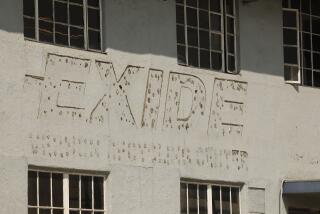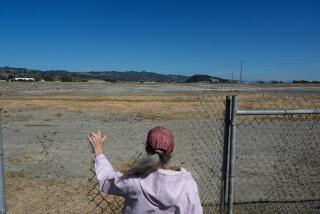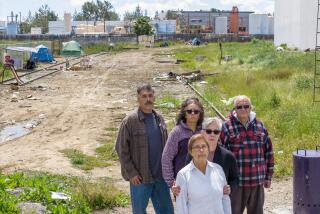Hanford cleanup project raising doubts
RICHLAND, WASH. — On a wind-swept plateau, underground steel tanks that hold the nation’s most deadly radioactive waste are slowly rotting. The soil deep under the desert brush is being fouled with plutonium, cesium and other material so toxic that it could deliver a lethal dose of radiation to a nearby person in minutes.
The aging tanks at the former Hanford nuclear weapons complex contain 56 million gallons of sludge, the byproduct of several decades of nuclear weapons production, and they represent one of the nation’s most treacherous environmental threats.
Energy Department officials have repeatedly assured the public that they have the advanced technology needed to safely dispose of the waste. An industrial city has been under development here for 24 years, designed to transform the sludge into solid glass and prepare it for permanent burial.
But with $13 billion already spent, there are serious doubts that the highly complex technology will even work or that the current plan can clean up all the waste. Alarmed at warnings raised by outside experts and some of the project’s own engineers, Department of Energy officials last year ordered a halt to construction on the most important parts of the waste treatment plant.
“They are missing one important target after another,” said Sen. Ron Wyden (D-Ore.), chairman of the Energy and Natural Resources Committee. “It feels like we are going around in circles.”
Over the last two years, technical problems on the project have multiplied. Concern has grown that explosive hydrogen gas could build up inside the treatment plant’s pipes and tanks. Clumps of plutonium could form inside the plant’s mixing tanks, some engineers now say, potentially causing a spontaneous nuclear reaction.
A federal oversight board found that employee safety concerns had been discounted, while the Energy Department’s inspector general reported an estimate that more than a third of the plant’s nuclear safety reviews -- required on every pipe, valve and device -- were never conducted.
Senior engineers at Hanford have voiced similar worries.
Gary Brunson, then the federal engineering chief at Hanford, recommended a year ago that the prime contractor, Bechtel National, be removed as the plant designer, citing 34 instances of serious safety and engineering errors. Two other senior managers have also publicly said the project’s technology is flawed and that safety concerns have been disregarded.
Federal officials and executives at Bechtel downplay the risk of a nuclear accident and say they are making important progress on a difficult job.
“We have a lot of challenges, but I am confident,” said Bill Hamel, the federal manager who is directing construction of the waste treatment plant. “This is a very large, very complex facility. We continue to make progress.”
This month, however, the Energy Department formally offered a more cautious prognosis. It notified Washington state officials that it might miss some of the most important project deadlines, promised three years ago under a consent agreement reached to address earlier lapses. Now, 14 of 19 key milestones are in jeopardy, the department has acknowledged.
But endless delays are hardly an option -- not when a million gallons of sludge from about a third of the 177 underground tanks have leaked into the soil, and some of it has reached aquifers under the plateau.
The Columbia River, the West’s biggest waterway, is seven miles downhill from the waste and, under a worst-case scenario, could be hit by the plumes in as little as 50 years, according to the Washington State Department of Ecology.
“It is really disappointing,” said Suzanne Dahl, who runs the department’s Hanford office.
In late September, Energy Secretary Ernest J. Moniz tried to intervene with a vague plan for accelerating the project. He offered options that included the development of a new treatment plant and a change in the chemical process for treating some of the liquid waste.
But Wyden, among other critics, dismissed it, calling it “a plan for a plan.”
Many of the problems stem from the decision to launch construction of the plant even before engineers had completed the design. The job of turning waste as thick as peanut butter into glass is at the leading edge of nuclear chemistry, a job made difficult by the complex mixture of wastes that were fed into the underground tanks by some of the nation’s largest industrial corporations under a cloak of government secrecy.
The basic plan is to pump the waste into a pre-treatment plant, a factory larger than a football field and 12 stories tall, that would filter and chemically separate the waste into two streams of high- and low-level radioactivity. Then, two other plants would “vitrify,” or glassify, the waste. One would produce highly radioactive glass destined for a future geological repository, and the other a lower radioactive glass that could be buried at Hanford.
But serious questions were raised last year after Walter Tamosaitis, one of the scientific chiefs of the project, disclosed that the innovative technology for mixing the waste in processing tanks could cause dangerous buildups of explosive hydrogen gas and might allow plutonium clumps to form.
The Defense Nuclear Facilities Safety Board, an independent federal agency that oversees nuclear weapons sites, validated Tamosaitis’ concerns about the mixing technology and found that the safety culture at the project was flawed. Construction on the project’s two most important components, the pre-treatment plant and the high-level vitrification plant, was substantially slowed. Tamosaitis was fired.
The questions concern Bechtel’s decision not to use traditional mechanical mixers with paddles driven by electric motors, as have been employed at other nuclear processing plants.
Instead, the company chose pulse jet mixers, which function like giant turkey basters. Powered by vacuum and air pressure, they suck waste into a cylinder within the tanks and then spit it out under high pressure. Such a system has never been used in such large tanks. The decision was based on the concern that mechanical systems could break down in highly radioactive “black cells,” as the tanks are known, over the 40-year design life of the plant.
But doubts have grown about whether the pulse jet mixers can adequately agitate the waste and prevent the formation of hydrogen gas and clumps of plutonium at the bottom of the tanks and in pipes.
The safety board has demanded that the Energy Department conduct a full-scale test of the mixing system, using nonradioactive sludge, before going any further. The test facility is under construction near Hanford, but the test completion date is uncertain.
Project managers say they are not worried. Hamel said he is “100% sure” that whatever the tests show, the mixing hardware or the chemical processes can be adjusted to allow the treatment plant to fulfill its mission.
On a recent tour of the plant, Hamel navigated around walls 6 feet thick designed to protect workers from radiation.
Massive stainless steel tanks that can hold up to 375,000 gallons of sludge were lined up in areas that will someday be sealed off from human entry.
“This entire design is based on safety,” Hamel said.
Russell Daniel, Bechtel National’s technical director at Hanford, said the probability of an explosion is no greater than 1 in 1 million. And he said that even if 20 feet of hydrogen gas accumulated inside a pipe and detonated, it would not cause a rupture or any damage.
But some of the nation’s top independent experts say the Bechtel technology is far from proven.
“We are all out there at the frontier, trying to assess the technology,” said Rich Calabrese, a University of Maryland professor who is considered one of the world’s top experts in chemical mixing technology. “I am neutral about whether it will work or not.
“The Energy Department has to demonstrate that it will do the job. And people are working to make sure the right tests are done to answer that question.”
Others take a more pessimistic view.
“The pre-treatment plant will not operate as it was originally intended,” said Donna Busche, a nuclear engineer and health physicist who leads the project’s safety team at URS Corp., a Bechtel subcontractor. “The pre-treatment plant is a dog.”
Busche said she believed the facility would never be able to pass a licensing review because so many crucial tests had never been conducted and so many documents were missing.
Even if concerns about the mixers are resolved, the very earliest construction could resume on the high-level plant is now set for next year, and the pre-treatment after that.
And even if all of the technical doubts are overcome and if the lack of nuclear safety documentation can be resolved, there are serious concerns that the treatment plant will wear out before it can process all of the 56 million gallons of waste.
Energy Department officials acknowledge that possibility, and say they will need a second low-level vitrification plant to complete the job. When that will happen is unknown -- it is a project that Congress has not even authorized.
--
More to Read
Sign up for Essential California
The most important California stories and recommendations in your inbox every morning.
You may occasionally receive promotional content from the Los Angeles Times.











